

How Timewise supported a social impact investment organisation to create a framework and principles for flexible working conversations.

Big Society Capital exists to improve the lives of people in the UK through social impact investing. They unite ideas, expertise and capital to create investment solutions for the UK’s social challenges, supporting organisations that deliver both positive social impact and sustainable financial returns. The company has around 75 employees, with an office in central London.
Leaders at Big Society Capital have long been keen to ensure that their staff work in a way that fits with the rest of their lives, and helps them do their best work. 25% of employees work part-time, and the company is currently working to a hybrid model, with employees spending between 20% and 40% of their time in the office.
The HR team at Big Society Capital wanted to find a middle way between employees putting in formal requests for flexible working and having an informal chat. They were also determined to build on the positive learnings from the Covid-19 pandemic, and make sure they were firmly embedded.
Big Society Capital were aware of our long-held expertise in this are and sought our advice on the best approach.
Our team worked closely with the HR lead to explore the different options available. This included discussing a range of ideas and sharing examples of good practice from our other clients. We concluded that the best approach would be to create a framework and principles for discussion.
We collaborated with the team to create these, and received positive feedback and approval from the Executive Committee. Additionally, we sought feedback from managers, to check that they would work in practice, and delivered training on how best to implement them.
At the time of writing, the framework and principles are still relatively new. The HR team are committed to evaluating them on a regular basis and making any tweaks that are necessary. Plans include a formal evaluation through their next employee engagement survey, and a review of the number of formal and informal requests taking place following the change.
Anecdotally, the framework and principles have been well received. The team have put in place regular surgeries for staff to come and ask any questions they may have about how to use them.
The client’s view
“If you have a small HR team, having external expertise and support is incredibly helpful when you’re creating a new set of working practices. Amy was brilliant; she gave a huge amount of coaching, advice and feedback, and her depth of knowledge and insights from other organisations on what works meant we developed a really robust framework and principles which I’m confident will succeed.” Julia Boddy, Head of HR, Big Society Capital.
Guy’s and St Thomas’ is an NHS Foundation Trust that runs Guy’s Hospital in London Bridge, St Thomas’ Hospital in Waterloo, Evelina London Children’s Hospital, Royal Brompton and Harefield Hospitals and community services in Lambeth and Southwark. The Trust now employs 23,000 people.
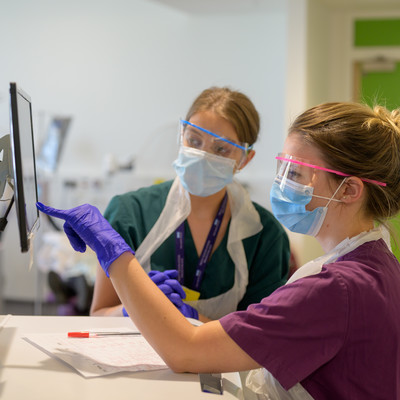
As director of workforce programmes, Lynn Demeda runs several strategic workforce initiatives at Guy’s and St Thomas’. Lynn is currently working on partnerships with other hospitals including the recent merger of Royal Brompton and Harefield Hospitals. This merger has resulted in the transfer of 4000 staff into the employment of Guy’s and St Thomas in February 2021.
Life before lockdown
Before lockdown, Guy’s and St Thomas’ had well founded policies with around 20% of staff working part-time and 57% of staff indicating they felt satisfied with flexible working support. The greatest barrier to more flexibility was mindset; some managers had their reservations around productivity, performance management and being able to sustain service delivery. Lynn and her team therefore worked to encourage open conversations about working differently and exploring options to support individual needs.
Corporate staff in office roles could work anywhere in both formal and informal arrangements with flexible hours and remote desktops. However, for those working on the front-line in patient facing roles, implementing flexible working was more challenging. As remote working was often not possible, team-based approaches to shift hours were crucial; it enabled some teams team to create a rota that considered both individual and service needs.
A concrete example of this was in the paediatric intensive care department. As a specialist role, paediatrics are often difficult to recruit and retain. The lead nurse had open conversations within the team about what hours staff wanted to work. A self-rostering approach was then adopted, giving the team more flexibility in their hours and the ability to swap with their colleagues.
Reacting to the crisis
When lockdown was announced, the Trust reduced several services such as elective surgery and dental services to focus on supporting Covid-19 patients. This meant staff could be redeployed into high demand areas. While redeployment was done based on demand, it meant staff had more flexibility to move departments and become multi-skilled; staff were trained in new skills to support them in taking on different roles.
To continue supporting patients, Guy’s and St Thomas’ introduced video and online consultations to replace most out-patient appointments. Using the secure platform ‘Attend Anywhere’, doctors could consult their patients remotely, be it the hospital or home. The teams have found this to be welcomed by patients and have seen reductions in DNA (do not attend) appointments, saving valuable time and enhancing patient experience.
Online consultations also changed how services were provided. For example, some patients who were previously treated on an individual face to face basis, moved to online group sessions in lockdown. It was well received by patients as they felt they could connect with people with similar experiences.
For those that continued to work in clinic, a blended working pattern was adopted. Roles were reviewed on a team basis to understand what needed to be done in the hospital, and what could be done at home.
These changes gave staff greater flexibility in where they worked, increasing uptake in home and remote working.
Supporting employees to keep working
Lynn and her team understood that moving from face to face delivery to a remote service was a big cultural shift that needed to be supported. A range of resources were available on how to work remotely. Seeing leaders and local-line managers as fundamental to change, Lynn’s team delivered online workshops on remote leadership. These sessions equipped managers with the knowledge to set out clear expectations; building trust in teams and focusing on output rather than hours.
Additionally, the importance of personal well-being was highlighted in corporate messaging and on site: hospitals were made Covid secure, rest and recharge areas were created, and a supermarket was opened for staff to get their essentials. Additionally, psychologists were deployed to help address some of the staff’s experiences whether on site or working from home.
Learning from the experience
Covid-19 has accelerated Guy’s and St Thomas’ progression in new ways of working, supported by digital transformation. The majority of outpatient appointments are now done virtually, with only critical sessions being delivered face to face. This process has allowed employees to rethink where and how they work; roles that previously had to be onsite can now be done remotely.
For Lynn, one of the biggest learnings is the need for team-based decision making. The pandemic forced managers to make quick decisions on a local line basis. Involving staff in these processes helps to find sustainable solutions that met team, individual and service delivery needs.
Lastly, prioritising employee well-being has highlighted the importance of flexible working. This has been two-fold; Guy’s and St Thomas’ offered staff flexibility to support work life balance, but staff had to be flexible in their roles to meet Covid-19 demand. Staff have acquired new skills and cross-functional working has helped foster a close community. Line managers now have frequent conversations and check ins with staff, proactively encouraging open discussions around well-being and work-life balance. Lockdown has normalised these conversations and adjusted the focus from hours to output.
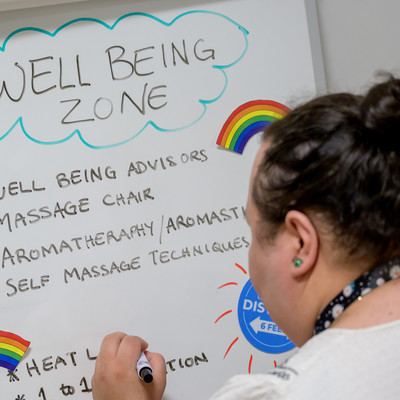
As a clinical nurse specialist on the Integrated Respiratory Team, Ellie Linacre supports inpatients with COPD asthma or those who require home oxygen. Ellie also does community work, working with COPD patients and conducting home visits.
Life before lockdown
Before Covid-19, Ellie worked a five-day week: four days supporting inpatients and the other day doing community work. Ellie had the flexibility to change her community days as and when inpatient case load needed.
Working 8:45-4:45pm and often on weekends, Ellie and the team covered the respiratory service every day of the year. This meant working seven days in a row over the weekend, followed by two days off. This working pattern did make work-life balance challenging.
Working through the crisis
Almost overnight, Ellie’s team of physiotherapists and respiratory nurses was reduced to five members as the others were redeployed to intensive care. As most of Ellie’s work is based in the hospital working with patients, Ellie was unable to work from home.
Wanting to provide the same level of service to their patients, Ellie and her team quickly decided to work 9.5-hour days. Their shift pattern changed to four days to account for the long hours. Working through Covid-19 peaks was exhausting so the flexibility to change their shift pattern helped avoid exhaustion.
Using a team-based approach, the team submitted their shift requests to Ellie who then built the rota. Ellie divided the weekend hours equally making sure there was always two people on shift. Those with child caring responsibilities were prioritised. The process was fair and amongst all the chaos the rota offered stability in being one of the few things Ellie could control.
Support from employers
Leadership were very supportive and delighted that the team wanted to deliver the same level of patient care through lockdown. There was the right balance in having access to guidance and resources and being trusted to make decisions at a team level.
The core team also had a Whatsapp group to keep everyone updated and in touch. Whether it be providing updates on patients or Ellie sending pictures of her pet tortoise, the group became a space for team interaction.
Additionally, the team would have weekly meetings with those that had been redeployed. This meant when they returned to the department, they were up to date with patient care and aware of the new pattern. Once the team was reunited, theyunanimously choose to continue working in the new pattern, collectively discussing any improvements.
Learning from the experience
Using a team-based approach has been crucial to this period. More recently the team have been allowed to self-rota. This has saved Ellie a lot of time and allowed the team to build a greater awareness of each other’s needs and preferences.
Before lockdown around 50% of the team worked later. With new shift patterns, fewer members of staff are working beyond their hours. Extending shift hours appropriately has given the team enough time to complete administrative tasks on the clock.
The freedom to explore and trial different working patterns with Guy’s and St Thomas’ support has given Ellie greater flexibility. This time has also taught Ellie to appreciate rest time, looking out for her own well-being as well as her patients.
This case study is part of a series supported by The National Lottery Community Fund, as part of their Emerging Futures Fund
Click on the links below to read the other case studies in the series:

Nicky Freeling is Head of iWork for Islington Council’s employment service and Dionne Gay is the iWork service development manager. Together, Nicky and Dionne look after Islington’s front-line employment coaches and job brokers.
Life before lockdown
Islington Council has always been a forward-thinking employer offering a range of working arrangements. The council’s culture is very proactive in encouraging open conversations around flexible working. However, flexibility is limited by role. Those working in front-line jobs have more rigid working patterns to meet Islington’s needs.
Before lockdown, the iWork service often met with employers and candidates to offer their employment services; understanding client needs, screening candidates and attending panel interviews. Flexible working hours were also limited by iWork’s call centre operating from 9-5pm. Someone was always needed to answer calls.
Reacting to the crisis
When lockdown was introduced, iWork started to work remotely. After understanding employee needs, Islington quickly distributed technical equipment to help create a proper home working environment.
As job brokers the team could still operate from home, conducting online client and candidate consultations. But as the line between home and work was blurred, Nicky and Dionne found their team were under increased pressure. Spending hours on calls and Zoom was not beneficial for employee well-being. They encouraged the team to have at least one hour a day without any ‘Zoom time’. This meant restructuring their working pattern and cleverly booking meetings.
Additionally, Nicky instructed her team to book a lunch hour in their diary to ensure they were taking adequate breaks. It also helped with team efficiency as employees could see when their colleagues were not available.
During lockdown, working hours also became more flexible. The focus shifted from working hours to output. With individuals with caring responsibilities and others juggling home-schooling, Dionne understood that everyone had different needs to work flexibly. The team were encouraged and supported to work the hours they could.
Supporting employees to keep working
On a company-wide level, Islington Council introduced measures to try and encourage work-life balance. There was clear and frequent messaging prioritising well-being and promoting “walking and talking”. The council stated that all meetings must start at five past the hour and end at five to the hour to avoid back to back meetings.
Within her team, Nicky set out clear expectations; the focus would be on output and well-being as opposed to hours and patterns. Nicky introduced a weekly team walk on Thursday mornings, encouraging her team to get some fresh air and take a photo of their view to share in their WhatsApp group. Nicky also managed an individual suffering from long Covid. Exhausted by normal hours, she suggested taking a break from 2-4pm to help the individual continue working effectively.
As lockdown began to ease, Nicky cycled to meet everyone in her team face to face. Abiding to government guidance they would sit outdoors and discuss work. These conversations helped employee engagement and encouraged open and honest conversation about how they were coping.
Learning from the experience
Dionne and Nicky have used lockdown as an opportunity to try new patterns of working in their teams. Recognising that simply lifting office behaviours into the home environment isn’t beneficial for employee well-being, they have encouraged their teams to capitalise on the benefits of remote working. For example, taking time to do a yoga class and making up the extra time when it suited them. The teams started to achieve a greater work-life balance and find new lockdown hobbies.
Moving forward, the council will continue to rethink where and when work can be done most effectively: employees will not have to return to a five-day week in the office, meetings that require a lot of travel will continue to be done remotely and hours will remain flexible to individual needs. This process is part of Islington’s pursuit to continue finding and developing smarter ways of working that enable their employers to work better.

Lisa Smith* is one of Islington Council’s employment coaches. Working in the health and social care sector, Lisa works collaboratively with both employers and candidates. As the pandemic staggered the job market, Lisa’s work has become increasingly important in helping those made redundant find new work.
Life before lockdown
Before Covid-19, Lisa worked in the office four days a week. With a progressive employer, Lisa could work flexible hours but it was often tailored to meet client needs. As part of her role, Lisa met face to face with both employers and candidates, to understand employment needs and candidate’s skillset and experience.
This working pattern did allow Lisa to achieve a good work-life balance. Lisa’s working hours allowed her to balance her home commitments, and left time for socialising with friends and exercising frequently.
Working through the crisis
When lockdown was introduced, Islington Council were quick to act with the introduction of home-working. At a serious and scary time, line-managers offered clarity and were clear that employee well-being was a priority.
There was an adjustment period in adapting to home-working. Lisa found she could work productively, delivering over 55 job outcomes at the height of lockdown. However, the biggest challenge was the feeling of isolation and detachment from the rest of the team. Over time and with the help of team catch ups, Lisa learned to enjoy the benefits of home working: making sure to watch her favourite cooking show and do daily exercise.
Lisa continued working similar hours as she enjoyed the routine and structure. However, Lisa knew that if she needed to take time out to reset, she was trusted to make up the hours when it suited her.
Support from employers
On a company-wide level, Lisa found Islington council’s messaging clear and transparent, navigating employees through uncertain times. It was clear employee well-being was the priority. Lisa could also request working from home equipment such as a bigger screen or desk chair. These small physical changes improved Lisa’s working environment.
At a managerial level, Lisa felt trusted and supported to work in a way that suited her best. Weekly ‘walk and talk’ meetings were helpful in boosting team morale and motivation levels, giving Lisa valuable time away from her desk. Lisa was also supported through weekly one to one meetings with a line manager. Honest and open conversations about well-being and workload meant Lisa could raise any issues. This frequent contact also helped reduce the loneliness of remote working.
Learning from the experience
Moving forward, Lisa would like to adopt a blended working pattern of home and office working. This experience has made Lisa realise how efficient and effective remote-working can be, reducing commute time and allowing for a better work-life balance.
Despite the pandemic, Lisa continues to enjoy her role and the diversity and challenges it brings. Islington’s culture of trust and the ability to work flexibly has enabled Lisa to continue working and delivering.
This case study is part of a series supported by The National Lottery Community Fund, as part of their Emerging Futures Fund
Click on the links below to read the other case studies in the series:
Rowlinson Knitwear is an employee-owned supplier of high quality schoolwear and corporatewear, employing 58 people. Despite the barriers to flexible working in the manufacturing industry, Rowlinson offer a variety of flexible arrangements to suit employees’ different needs, and aims to be an employer of choice.
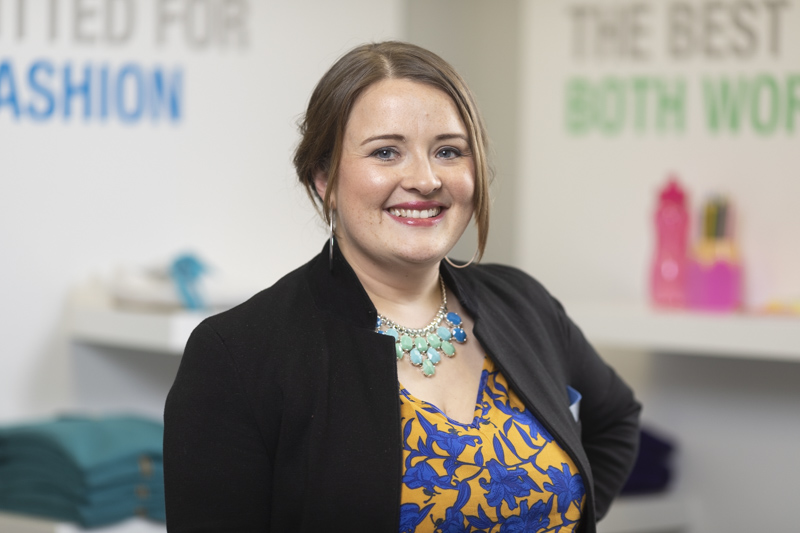
Nicola Ryan is Rowlinson Knitwear’s Colleague Support Director. She is responsible for ensuring the wellbeing of colleagues and removing any barriers to enable them to work better.
Life before lockdown
Three years before the pandemic, Rowlinson relocated to new and larger premises, using the move as an opportunity to review working practices. One key issue which the review revealed was the lack of communication between the day and night shift production teams. In response, the decision was made to alter work patterns and create an early shift and a late shift. This meant no one had to work through the night and created a fluid, more inclusive handover between the teams. They also offered a two-day mental health training course, in which 40 members of staff took part.
An additional decision was taken to reduce the working week by two and a half hours across the whole company, with no reduction in pay. This increased employee wellbeing, without reducing service output.
Reacting to the crisis
With good flexible working practices already in place, Nicola acted quickly, by shifting vulnerable colleagues to full-time home working with flexible hours. Those that needed to shield and were unable to work in the warehouses were put on furlough; at the height of lockdown, 80% of the workforce were furloughed.
During this time, the team’s biggest concern was loneliness and mental health; they supported this by ensuring that every colleague received a weekly phone call to check in. The leadership team also volunteered to reduce their pay by between 10 to 50% to support lower paid colleagues. This meant furlough pay was topped up to 90% of normal earnings.
For those that couldn’t work from home, the priority was to make the building COVID-19-compliant. Nicola helped ensure all hygiene regulations were met and created video tours of the building to share the changes. Following individual and team conversations, a skeleton rota was created for those in the production team who could work, along with new shift times to reduce cross over.
The warehouse team managers also reviewed their working arrangements, and realised parts of the job, such as processing customer orders, could be done remotely. The resulting hybrid working pattern gave them greater flexibility in where they worked.
Supporting colleagues to keep working
With regular catch ups, resources for guidance and open communications, Nicola and the wellbeing team supported their colleagues in a number of ways.
Firstly, they were more flexible about where and when roles were delivered, shifting their focus from hours to output. This involved trusting managers to work and communicate more closely with their teams, so that the arrangements met individual needs.
Secondly, the team invested time and resources to equip staff with the knowledge and skills needed to work in different departments. This highlighted the importance of multi-skilling colleagues, enabling redeployment rather than furloughed; a real benefit for a seasonal business.
Lastly, the wellbeing team’s priority was to diminish worries and anxieties around work as much as possible. They frequently checked-in on an organisational and individual level, encouraging open conversations.
Learning from the experience
Lockdown has taught Nicola and the team that roles that they previously thought couldn’t be done from home, often can be. A concrete example of this is Rowlinson Knitwear’s core customer care team. Before the pandemic, they were all office based. But during the crisis, they’ve learnt that only one member of the team needs to be present at a time. This learning has given them greater flexibility by rotating which colleague goes into the office.
Another key learning has been the importance of communication. Having honest conversations at team and individual levels allowed colleagues to contribute to finding appropriate flexible solutions, rather than having company-wide decisions imposed on them. This openness has also helped overcome some of the loneliness caused by remote working, and contributed to a well-being focused culture.
Moving forward, when recruiting for new vacancies, all roles will be advertised with flexible working. The team have already seen the benefits, reaching a new talent pool of candidates.

Shane Banham is one of two warehouse team leaders at Rowlinson Knitwear and is responsible for ordering, receiving and processing all the goods.
Life before lockdown
When Rowlinson reviewed working practices three years ago, production workers were given the choice between early or late shifts; 6am-2pm and 2pm-11pm. Shane chose to work the early shift from 6am-2pm. This allowed Shane to balance his work with caring for his three young children; collecting them from school and spending time with them in the evening. But the shift had its drawbacks, with early mornings in the winter taking a toll on Shane’s mental health.
Working through the crisis
Working in production and overseeing the warehouse team meant that Shane couldn’t work remotely during lockdown. The introduction of a skeleton shift at the end of March involved a review of which team members would be furloughed; Shane considered vulnerability, location and skillset, and choose a team of four to continue working.
While the warehouse team could have continued with the pre-COVID-19 6am-2pm shift, it didn’t meet client needs. Instead, Shane consulted his team and initially decided on a 7am-3pm shift. Additionally, following the realisation that parts of the role could be done remotely, he introduced the option of working from home for part of the week. This meant Shane could focus solely on the physical tasks while on site, and allowed him to spend more time with his family at home.
Ironically, improved team communication meant that those who were still working became frustrated by the extra time their furloughed colleagues were getting with their families. This was raised with the wellbeing team and led to the introduction of flexi-furlough, allowing staff to rotate on and off furlough. This freedom allowed Shane to go on furlough in May so he could take a much-needed break and his partner could return to work.
Support from employers
Shane noted a high level of support during this time, with frequent phone calls and occasional visits to the site from the wellbeing team. Weekly updates and clear communication helped to ensure he and his team felt cared for. Shane felt trusted by leaders to find a solution that worked for him on an individual and team basis.
Learning from the experience
Shane has been able to find opportunities within the crisis, with a positive impact on his personal development and responsibility over his team. The process highlighted the importance of listening to individual needs and being open minded to different ways of working.
Moving forward, the warehouse team leaders have decided to work at least one day a week from home, with the freedom to choose which day. In the longer term, Shane would be keen to explore greater flexibility in shift patterns, but given the logistical restrictions of production, appreciates the family time the current pattern allows him.
This case study is part of a series supported by The National Lottery Community Fund, as part of their Emerging Futures Fund
Click on the links below to read the other case studies in the series:
BAM Nuttall is part of the Royal BAM Group, one of Europe’s largest construction companies. The company employs over 3,000 people across 100 projects, aiming to create sustainable environments that enhance people’s lives. Remote and flexible working is rare within the construction sector, which has historically been based on a clock-in, clock-out, on-site way of working.

Rob Lewis is BAM Nuttall’s framework development manager. He heads up the York office, overseeing around 50 people. He has long believed that flexible working is possible, and even desirable, within the construction sector.
Life before lockdown
Rob’s team already had access to both informal and informal flexibility in the pre-Covid-19 days. Some members of staff worked part-time, and there were no formal start and end times; the assumption was that as long as the work was done, the timings could be fluid.
Additionally, 18 months before the pandemic, Rob instigated a system in which every member of the team were allocated a set ‘working from home’ day (with their input into which day). Mindful that this was a radical move for a construction company, Rob provided clear guidance on expectations.
Introducing a work from home day for on-site supervisors was more complex. However, discussions with the team highlighted that around 20% of their workload was planning, paperwork and documentation, which could be chunked into one day and carried out from home. This had the additional effect of making their on-site time more focused – and gave more junior colleagues the chance to act up.
The pilot highlighted the importance of having the right mindset, with some members of the team initially slipping into referring to their non-office day as a ‘day off’ and others struggling to work well remotely. This was identified by staff survey and open conversations, and tackled on an individual basis so that the arrangement could be made to work for everyone.
Reacting to the crisis
The pilot meant that the York team were able to move swiftly into full-time remote working when lockdown was announced. They had the technology and equipment in place and were already operating as a paperless office.
In the weeks that followed, Rob and his team ran surveys to understand the challenges that people were facing, covering a range of topics from homeworking environment and family responsibilities to medical constraints and emotional wellbeing. They also invested in extra office furniture and technology, to ensure people were correctly set up for long-term homeworking.
One key learning from the early weeks of lockdown was that communication was more difficult, and the lack of informal ‘kettle talk’ was having a knock-on effect on team morale and cohesion. It also became clear that a number of employees were struggling with the day to day reality of lockdown (rather than work issues). The team dealt with this by putting in place regular virtual check-ins and social events, picking up the phone to check how people were doing, and offering further advice and support through an employment assistance programme.
Supporting employees to keep working
There were two main ways in which Rob and his team supported their employees to stay in their jobs during lockdown.
Firstly, they created flexibility around when roles were delivered; as long as the work was done within a reasonable timeframe, they were relaxed about specific timings. This supported those with children to work around the needs of their families. And secondly, Rob made it clear to all members of staff that if at any point they needed time out, they were to take it, no questions asked and no explanations needed.
As a result, the whole team were able to keep their jobs and manage them around their personal circumstances.
Learning from the experience
Rob’s work to increase flexible options for the team, both before and during the lockdown, is reaching wider than the York office. He is now talking to the business leaders about rolling out his pilot across BAM Nuttall as a whole, and shares insights from his regular surveys with other leaders to help them understand the impact on the workforce.
One concrete example of this has been in the way that the company manages apprentices. Rob’s team identified that the York office’s apprentice was struggling more with lockdown than others; he has shared this with BAM Nuttall’s development and training department, who oversee 300 apprentices, and is now having monthly meetings with the department to give extra support.
A plan has been put in place for transitioning back to the office when circumstances allow. Some members of the team, for mental or physical health reasons, will remain based at home, but Rob is mirroring his pre-Covid system by asking them to have a ‘working in the office’ day. Those who can go in have been split into two groups and will work under a rota system of two weeks in, two weeks at home, to allow safe distancing.
Rob believes that the open conversations and shared trust which developed during lockdown will be key to making a success of this new blended model of working. Her will continue to seek regular feedback from his team about what is working well and what could be done better, and is open to refining the model as time goes on.

Lucy Davidson is an office manager at BAM Nuttall. Lucy is tasked with organising the office, maintaining a shift schedule and resolving any resourcing issues on the ground.
Life before lockdown
Before Covid-19, Lucy was in BAM Nuttall’s York office full-time. Commuting in from Lincoln, Lucy would stay in York during the week and return home on Friday for the weekend.
There was some flexibility in hours. As construction sites often started working earlier, Lucy would start at 7:30am in the office to effectively support site staff. This meant she could finish earlier in the afternoon.
In the middle of 2019, a work from home day was introduced. After submitting her preferences, Lucy was assigned her first choice: Fridays at home. Working one day remotely meant Lucy could travel home to Lincoln on a Thursday night and achieve a better work-life balance.
Working through the crisis
When lockdown was announced, Lucy began working from home full-time. Lucy initially struggled working remotely from her dining room table. However, by creating a proper work environment with a desk and chair, Lucy found she could work productively.
As restrictions eased, Lucy adopted a more blended pattern. By working two weeks in the office and then two weeks from home, Lucy could reduce her travel with her apprentice covering the weeks she was out of the office. Lockdown encouraged Lucy to evaluate her role and where work could be done most effectively: leaving the administrative tasks for home-working and training and people led tasks for the office.
Now as the apprenticeship has finished, Lucy works on a two-week rota: three days in the office in the first week and two days in the second. This means Lucy is in the office every week to ensure everything runs smoothly, but allows her more time at home.
Support from employers
When Lucy initially started working from home, she felt isolated and detached from the rest of the team. Raising this issue to her manager, Lucy began having regular check-ins and informal conversations with the team to increase inclusivity.
Lucy also struggled to draw a line between home and work, feeling the need to be in front of her laptop all the time. After a 1:1 conversation, Lucy was encouraged by Rob to take a proper lunch break, stepping away from her workspace. This was all part of the process in Lucy realising she was trusted to work in her own time; manager mentality had shifted from focusing on hours to output. BAM Nuttall’s culture of trust meant Lucy didn’t feel micromanaged and gave her the confidence to work independently.
Learning from the experience
The pandemic has made Lucy realise she was spending too much time away from home. By being obliged to revaluate where her role could be done, Lucy has had greater flexibility where she works.
BAM Nuttall’s support and flexible culture has allowed Lucy to achieve a better work-life balance. Moving forward, Lucy would like to continue working a hybrid pattern of office and home working.
This case study is part of a series supported by The National Lottery Community Fund, as part of their Emerging Futures Fund
Click on the links below to read the other case studies in the series:

The Christie NHS Foundation Trust comprises a specialist cancer hospital based in Withington, Manchester, with satellite centres at Oldham and Salford. It is also a founding partner of the Manchester Cancer Research Centre, alongside with Cancer Research UK and University of Manchester.
The Trust employs over 3,000 employees and was the first NHS high-energy proton beam therapy centre in the UK, providing an advanced form of radiotherapy.
All NHS Trusts face challenges with recruitment and retention, as there are fewer people than there are roles that need filling. Additionally, NHS Staff survey results highlighted that the Trust was not perceived by staff to be open to flexible working, even though there were some pockets with excellent provision.
The HR team at the Christie came to Timewise because they wanted to proactively address these challenges. they also wanted to differentiate their organisation from other local trusts as a great place to work, which proactively encourages a positive work/ life balance.
The team felt that their reputation for delivering outstanding patient care needed to be mirrored by one of delivering outstanding staff care. They wanted to develop a proactive approach to flexible working which was open to all, whatever their personal circumstances, and to be known to be supportive of staff engagement, wellbeing and work life balance.
Following a recommendation, they approached us to support them in a programme to develop a more flexible culture and practice.
The programme began with a kick-off workshop, hosted by Timewise and attended by a project team made up of a cross-section of senior managers from across the Trust. We then carried out an audit of the Christie’s flexible culture, data and policies, and some staff engagement sessions.
Using the feedback from these sessions, we then ran a visioning workshop with the project team, helping them understand their current position on the Timewise Flexible Maturity Curve and where they wanted to get to. This was followed by an action planning workshop with the project team. We then supported the creation of a flexible working action plan which set out clear goals for the next two years.
The Covid-19 pandemic has put the implementation of the action plan on hold, and so limited the learnings that have been gathered at this stage. However, it has also helped remove some of the barriers to flexible working that had previously existed, and encouraged a perception that flexible working can be made to work.
Early learnings from the programme to date include:
Goals written into the action plan include:
Setting up a flexible working/job share pool to help staff buddy up and share roles.
Working in partnership with Timewise to expand our flexible working practice was a real success. It was so helpful to have an external insight into our flexible status and what we needed to do next, and we felt confident about being guided by their expertise. As well as hands-on support for each of the programme stages and events, they were responsive and helpful with any questions or issues we uncovered, and felt like a part of our extended team.
Natalie Marshall, Head of Operational HR, The Christie NHS Foundation Trust
Resources for Autism provide practical services for children and adults with a diagnosis of autism and for those who love and care for them. They employ 250 people and have 80 volunteers. The organisation offers a range of part-time and flexible arrangements. However, the need to provide face to face client support makes flexible complicated for some.

Dolyanna Mordochai joined Resources for Autism (RFA) as chief executive two months before lockdown. She is responsible for overseeing the delivery and development of RFA’s support services and fundraising.
Life before lockdown
Flexible working has always existed at the RFA, with those in office based roles able to work part-time and flexible hours.
The greatest barrier to more flexibility was mindset; there was a view that, to be managed effectively and work productively, you had to be present. Working from home was therefore the exception, and while it would be accommodated on request, it was not actively encouraged.
For those working on the frontline, providing practical help for children and adults with a diagnosis of autism, working hours were not as flexible. Full-time autism support workers had to fulfil a certain number of support hours visiting several families each week, and the nature of the role often meant anti-social hours, particularly after school when families need most support.
Reacting to the crisis
When lockdown was announced, there were two points for Dolyanna to consider: the need to keep the office open to continue providing support services, and the risk to employees. As RFA’s CEO, Dolyanna understood that to be a safe employer, they needed to accommodate to all individual needs, and that their employees’ emotional well-being was critical to their ability to support others.
Through staff surveys and individual conversations, Dolyanna and her team created a skeleton rota with those comfortable working in the office. They set out clear expectations; there was no pressure to return to the office and employees were trusted to work around their own needs.
Any autism support workers on the frontline who were vulnerable or had caring responsibilities were furloughed, and RFA topped up their furlough pay to 100% of their normal salary. For those that continued to work, managers assessed the needs and location of clients to help reduce commutes. This was an open and collaborative process within teams to ensure it worked for everyone.
A blended working pattern was then adopted. Support workers visited the families most in need within reasonable distance, and provided online support sessions from home to others. Remote support sessions were not something that had been explored before. They were well received by clients, and gave support workers greater flexibility in their working hours.
Supporting employees to keep working
Dolyanna created a culture of trust that helped RFA navigate the crisis. The focus shifted from working hours to output – getting the work done in whatever arrangement suited the individual. RFA’s communications constantly highlighted the importance of self-care and well-being. This involved holding weekly team meetings with no agenda to discuss how everyone was feeling, and line managers having open conversations to check in.
In terms of practical measures, any formalities in working hours were loosened so that individuals could work effectively. For example, prior to Covid-19, the standard support session was a minimum of two hours. Support workers found a two-hour remote session impractical and tiring for both the client and themselves. Now employees can decide the length of time, tailoring to client needs to have a more valuable session.
Learning from the experience
For Dolyanna, one of the biggest learnings from the experience is the need to trust employees to work in the best way for them. Every part of the organisation operated better when employees were trusted to fulfil their responsibility, and that will continue after Covid-19.
Before lockdown, Dolyanna believed that presenteeism was key to productivity and good management. This time highlighted the efficiency of homeworking both on the interface with clients and giving greater flexibility to their employees.
There is still much to learn as RFA adjusts to delivering services remotely and flexibly. But their online support services are here to stay, during and beyond Covid-19. Whereas before the RFA were limited to operating in the London and West Midlands areas, they can now use remote sessions to reach and help families all over the UK. And offering homeworking is helping them to attract more and better candidates.
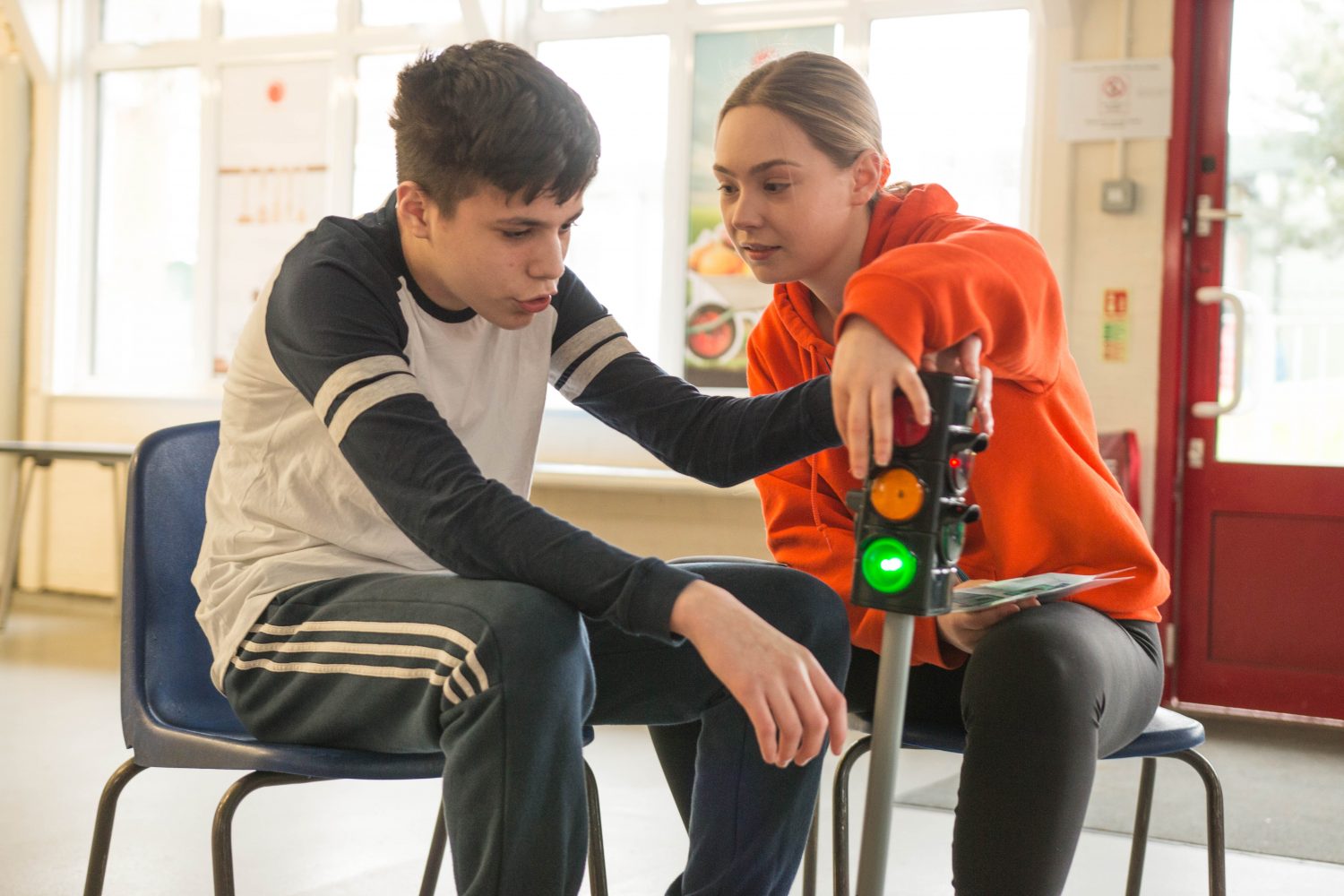
As an autism support worker, Megan Hurry is responsible for supporting nine families with an autistic individual and holding weekly evening clubs and care groups.
Life before lockdown
Before Covid-19, Megan worked a full-time 37.5-hour contract: Monday to Thursday and Saturdays. While working hours were restrictive, Megan had accepted this when she joined, and felt she was able to achieve a good work-life balance most the time.
Working through the crisis
When lockdown was introduced, Megan was very concerned about her clients. Part of her role is visiting people’s homes to interact with families – if the support had stopped it, would have detrimental effects to their mental health.
The biggest reassurance was the immediate response from RFA’s senior leadership team. By completing risk assessments and having honest conversations, Megan and her managers balanced what was safe for her and the families. Megan continued to work in her local community, supporting three families with restrictions in place (such as moving the session outside). For more distant families, Megan moved to online sessions either on Zoom or over the phone.
While there were no formal changes to Megan’s working hours, the pressure to fulfil a certain number of service hours was relieved. Instead, the focus was on delivering support, with Megan able to decide what was best for her clients. For example, before Covid-19 one of Megan’s clients would have a two-hour session each week. Megan found a two hour Zoom session unproductive, and instead changed to a 15-minute phone call a few times a week. Despite the time being reduced drastically, because there was less pressure to look at the clock, conversations were better and more valuable.
Delivering some of the sessions from home saved commute times and gave Megan more flexibility in her hours. Working from home also meant Megan worked more creatively: creating fun and engaging activities for semi-verbal clients.
Support from employers
RFA offered an abundance of guidance to help adjust to delivering care online. Megan’s behavioural managers organised weekly behaviour zoom sessions, and all employees had the opportunity to complete training courses for personal development.
Providing community support often means working independently. To encourage creativity and collaboration, Megan’s line manager arranged a weekly call with the team to discuss service users and brainstorm solutions to any issues. Ironically, these remote sessions meant Megan engaged with more of her colleagues than she did before Covid-19.
Megan felt that there was a good balance in feeling supported through clear communications and check-ins, but also feeling trusted by managers to work independently to do the job.
Learning from the experience
Megan initially struggled to adjust to home working. The blurred line between work and home meant Megan was overworking and exhausting herself. Lockdown taught Megan to be more protective of her non-working hours and be honest about capacity to take on more work.
Megan also became more aware of different ways of working that still allowed her to support clients. In some cases, families responded better to virtual support and it gave Megan greater flexibility in her working day. Being trusted to fulfil her responsibilities also means Megan has become a more confident worker; the freedom to try new ideas motivating her to work harder.
Moving forward, Megan is in a new role as RFA’s early help support worker looking at short-term intensive intervention support for children. Her reduced flexible hours has given Megan time to further her skills with a Masters in Child and Adolescent Mental Health.
This case study is part of a series supported by The National Lottery Community Fund, as part of their Emerging Futures Fund
Click on the links below to read the other case studies in the series:

When Sam White took parental leave from Aviva in 2017, and his colleague Will McDonald acted up to cover the role, they assumed it was just temporary. Now, almost four years later, they’re a job share success story, and proof that this kind of arrangement can have a positive impact far beyond the everyday.
It was while Sam was away that Will started to consider job sharing. He was keen to support his wife’s career, and to be around for his children for more than just evenings and weekends. So he floated the idea with Sam, who was keen to explore a part-time arrangement for the same reasons, and they decided to pursue it.
SAM: “Will had proved that he was ready for the Group Director role while I was away, and I knew we could make it work from a chemistry point of view; we’d been colleagues for a number of years, before and during our time at Aviva. So we put our heads together to sort out the practicalities, and pitched it to Kirsty Cooper, our boss, who has been incredibly supportive throughout.”
At that time, there was no one else at director level working in a job share. The role involves a great deal of internal and external stakeholder management, so they knew they would have to get their Executives comfortable with the concept. They suggested a six-month trial, and took on the responsibility of making it work.
WILL: “We explained to Kirsty that we would use the six months to prove that we could deliver as a job share – and that if she and the team didn’t feel we were working to a high enough standard, we’d accept their decision. In the event, even before the end of the trial, our Exec team agreed that it was a success, with one member telling us they had switched from being a sceptic to a convert.”
The pair took advice on how to succeed as a job share, and developed a set of principles which they would adhere to. They agreed three areas in which they would come together for decision making – changes in strategy, hiring, and spending over a certain amount – and that for everything else, they would take individual decisions, but have collective responsibility. They also instigated a framework for a written handover, as well as having a verbal handover on their crossover day.
The response from their colleagues has been overwhelmingly positive, and Aviva colleagues who are exploring a similar arrangement come to them for advice. They were also successfully nominated for the 2018 Power 50. But it was in 2019 that they discovered an additional benefit of their arrangement – the ability to navigate an emergency.
WILL: “Out of the blue, I experienced what I later discovered was a mental health breakdown, and was signed off work. Sam immediately stepped up, working a four or four-and-a half-day week for six months, until I was sufficiently recovered, to start the transition back in. And I took that process pretty slowly; it was another couple of months until I was fully back in the role.”
Clearly, Will’s wellbeing was his team’s first concern; but from a purely business perspective, having the job share in place made everything much easier. Instead of having to draft someone in to take over his role, they had Sam in place to run things, with a bit of extra support. And although it meant Sam had to increase his days, it was something he was happy to do.
SAM: “One of the great things about a job share is that everything works both ways – there have been times when I’ve needed to step back a little and have been able to rely on Will to pick up the slack. I was also able to take on a secondment opportunity which I was offered this year, and once again, the business wasn’t negatively affected, because Will simply took over.”
So from a business perspective, job sharing works on a number of levels. It gives you two brains for the price of one, a double hit of fresh energy in the week, and double the amount of thinking time, or ‘toothbrush time’ as Sam describes it. It is also a powerful attraction and retention tool.
SAM: “We all know the issues about the lack of women on boards and the gender pay gap. And yet the default is still that women work part-time and men go back to their old arrangement when they become parents. Job sharing allows people who want to work less than a full week to stay at a high level, and progress further, in a way that part-time doesn’t; it’s important that more people, men as well as women, are allowed and encouraged to do it.”
And as a built in emergency and succession plan, it’s second to none.
WILL: Neither Sam or I are intending to leave Aviva, but if one of us did, the succession plan is in place; the other one could take over, or recruit another partner. That seamlessness is such a bonus for an organisation, and it really came into play when I was struggling. Being able to switch off totally, knowing Sam was in control, made my recovery much easier, and I’ll always appreciate that.”

The statistics around teaching staff shortages are well known, but they bear repeating. Data from the NFER has indicated that targets for the required number of secondary school trainees have been missed for seven years in a row, and 33% of state school NQTs leave within five years. And while the Covid-19 crisis appears to have triggered a spike in graduate teacher training applications, it’s too early to say whether this will deliver sustainable growth.
Yet it is possible to buck these trends. There are a number of schools who are managing to hold on to their experienced staff at far higher rates than others. Step forward Huntington School, a community secondary in York, which has a miniscule staff turnover rate of 7%. Around half of teachers work part-time – including members of SLT – on contracts ranging from 0.2 to 0.8 FTE, and there are several job shares.
So, what’s the secret? According to Headteacher John Tomsett, it’s all about the culture. John’s philosophy is that good schools don’t just pop up overnight; they grow over time out of a supportive culture, led by the leadership, that guides the school’s vision in the right direction.
In practice, at Huntington School, this means busting the myth that part-time teachers have a negative impact on students, and that the timetable can only accommodate a few part-time jobs. It means understanding that happy teachers stay, and that supporting the other aspects of their lives allows a school to get the best out of them. And it means taking a positive, proactive approach to flexible working, with a process built on the presumption that “We will make it work.”
Leicestershire County Council is an organisation serving the residents of Leicestershire. The council employs over 6,500 employees and proactively offers a range of part-time and flexible arrangements. However, in certain roles that provide face to face services, flexible working may be more limited.
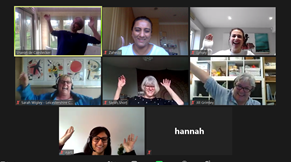
Tina Goswami is an Organisational Development Advisor for Leicestershire County Council. Using psychological and behavioural insights, Tina delivers various OD projects, coaching and team interventions to improve the organisational culture, productivity and wellbeing.
Life before lockdown
In 2014, Leicestershire County Council began their journey towards introducing and integrating smarter working across the organisation. This work, which Tina was involved in, meant the council offered a variety of flexible arrangements to suit employee needs before Covid-19. As a forward-thinking employer, Leicestershire County Council’s employees could work part-time, compressed and term time hours with flexibility in start and finish times as well as work from home.
The greatest barrier to more flexibility was service needs. The logistical constraints of some roles, such as road workers and librarians, meant working hours and location were not as flexible. However, there was more flexibility available for office-based staff who could work from home either occasionally or on a regular basis.
In 2019, a Workplace Project commenced to further embed smarter working practices looking at technological, workspace and people aspects, this work was being rolled out as the pandemic hit.
Reacting to the crisis
With good flexible working practices already in place, Leicestershire County Council acted quickly, shifting most staff to remote working. The organisation introduced a £200 home-working allowance for all staff to help create a comfortable working environment.
Leicestershire County Council set out clear expectations around working protocols and employees were trusted to work flexibly around their own needs. As a large organisation, the responsibility fell to departmental managers to ensure staff had access to home working advice, resources and could work effectively. Following open conversations, managers could create flexible arrangements to fit their team’s needs.
For those working in front-line jobs, the council carried out risk assessments and reviewed job design to understand which roles needed to continue working onsite. Depending on the role, a blended pattern of home and site working was adopted. For example, social care roles successfully adapted home visits to video calls with clients, reducing risk and travel time.
Supporting employees to keep working
There were three main ways in which the organisation enabled their employees to continue working during the pandemic.
More practically, they created a hub of well-being resources and support. This platform included advice on remote working, training packages for Microsoft Teams and regular updates on working practices in line with government guidance. The council also hosted a health and wellbeing week which was centred around key themes such as stress, resilience, sleep and health. Employees found the event very beneficial and have requested similar events to take place in the future.
Tina was also involved in delivering managerial workshops and 1-1 coaching sessions on managing remote teams. These interventions, along with the development of a ‘Managers Charter’ to set out leadership expectations, ensured managers were equipped with the knowledge to lead their team through the crisis.
Thirdly, the organisation further encouraged flexibility around when and how work was delivered. The priority was employee wellbeing and work was measured on output not on specific hours. Creating this culture of trust supported those with caring responsibilities to work around their own needs.
Learning from the experience
For Leicestershire County Council, one of the biggest learnings has been the importance in trusting employees to work in the best way for them. Lockdown has made some previously resistant managers understand and see the benefits of flexible working as productivity increased.
The Covid-19 pandemic made the case for smarter working clear and enabled the organisation to push forward the existing flexible working policies further. Roles which previously had to be done in the office, such as ICT and customer services, have now successfully been moved to remote working.
Moving forward, Tina hopes that the organisation will retain the increased flexibility. Adopting a blended pattern of working, the council is considering how to return to the office, using the space as a hub for creative and collaborative meetings. Tina believes that the open culture and increased trust which developed during lockdown will be key to making a success of this new blended model of working.
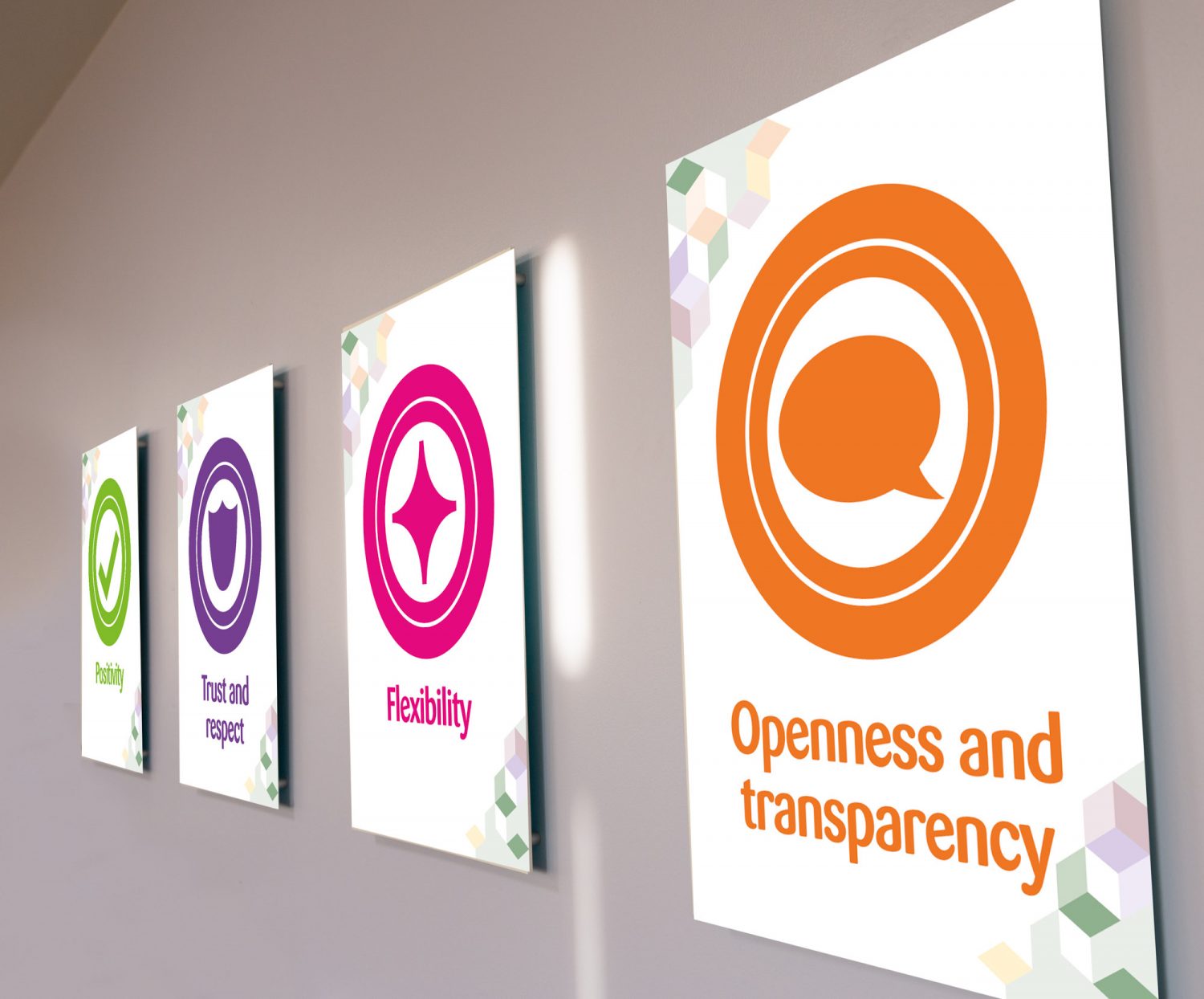
Cassie Kemp and Marissa Gisbourne are librarians at Leicestershire County Council’s Creative Learning Services. Cassie and Marissa are based in the Learning Hub in the Eastern Annexe and visit schools when required to host sessions; offering a subscription service to support school curriculums and promoting reading for pleasure.
Life before lockdown
Before Covid-19, Cassie and Marissa both worked a blended pattern between the Learning Hub and schools. As a team Creative Learning Services’ scope of work is three-fold: offering resource loans, learning workshops and professional support. This means a team members day to day activities can vary from selecting books for a school or delivering workshops to all age groups.
Cassie worked a full-time contract in the office or in schools, with a good work-life balance working 9-5pm hours. Homeworking was available if Cassie needed it, but it was an exception to her normal pattern.
On the other hand, Marissa worked part-time three days a week. Working Tuesday to Thursday from 8:30-4:30pm allowed Marissa to balance her work with looking after her children.
There was flexibility in hours on both sides as sometimes the role required an earlier start to align with school hours.
Working through the crisis
When lockdown was introduced, the whole team started working from home. As their work often entails working face-to-face in schools, the team discussed how they could continue to provide their services. The biggest change was shifting their school workshops online. This process allowed for team creativity as they shared thoughts on how to create engaging content.
However, some of the team still needed to be in the office to sort and select resources to send into schools. Once employees were allowed to return to council buildings a rota was created to limit the number of people on site and considered individual needs. As a low risk employee with no caring responsibilities, Cassie was one of the first people back in the library.
With fewer people working with direct access to resources, the team had to re-evaluate their working practices. Previously each member had a set of schools they were responsible for. With lockdown, this shifted to the team working collaboratively to cover the workload in regards to selecting resources to send into schools. Work that could be done remotely, such as key wording new books on the services’ library management system, was allocated to those needing to work from home. And tasks such as sorting and scanning new resources was done by those present in the library. This style of working created a collaborative team environment.
For Marissa, it quickly became apparent that juggling work and home-schooling young children was not effective. Marissa worked closely with her manager to informally agree flexible working hours to meet her needs. With the flexibility to start early or finish late, Marissa also tried to carve out set working hours in the day so the team could contact her. This flexibility in hours was vital in enabling Marissa to continue working.
Support from employers
Within the wider council, there was an abundance of resources and guidance to help employees adjust to different working patterns. In addition, transparent communication from leadership and open forums helped to address any concerns Cassie and Marissa had. Leicestershire County Council also conducted surveys to understand employee sentiment, responding quickly to any negative feedback.
Cassie and Marissa’s managers held bi-weekly virtual meetings to check in with the team. They were encouraged to try different ways of working that suited them and because of this flexibility, were the first service to fully recover in the Communities and Wellbeing department. Both Cassie and Marissa felt trusted to work around their own needs in a supportive inclusive culture.
Learning from the experience
Lockdown has taught both Cassie and Marissa about the different ways of working. It highlighted the efficiency of homeworking both on the interface with clients and having greater flexibility in their own time. It has also allowed the library to expand their client services, offering a mix of in person and online sessions.
The pandemic has allowed the team to gain a better understanding of where work can be done most effectively, saving the quieter tasks for at home. Moving forward, Cassie will look to return to full-time office working, knowing she can work remotely if needed. On the other hand, Marissa hopes to continue with some home-working to help balance work and childcare.
Despite the struggles of lockdown, flexibility enabled both Cassie and Marissa to continue working and delivering their roles, feeling lucky to work for an employer that trusts them to get the job done.
This case study is part of a series supported by The National Lottery Community Fund, as part of their Emerging Futures Fund
Click on the links below to read other case studies: